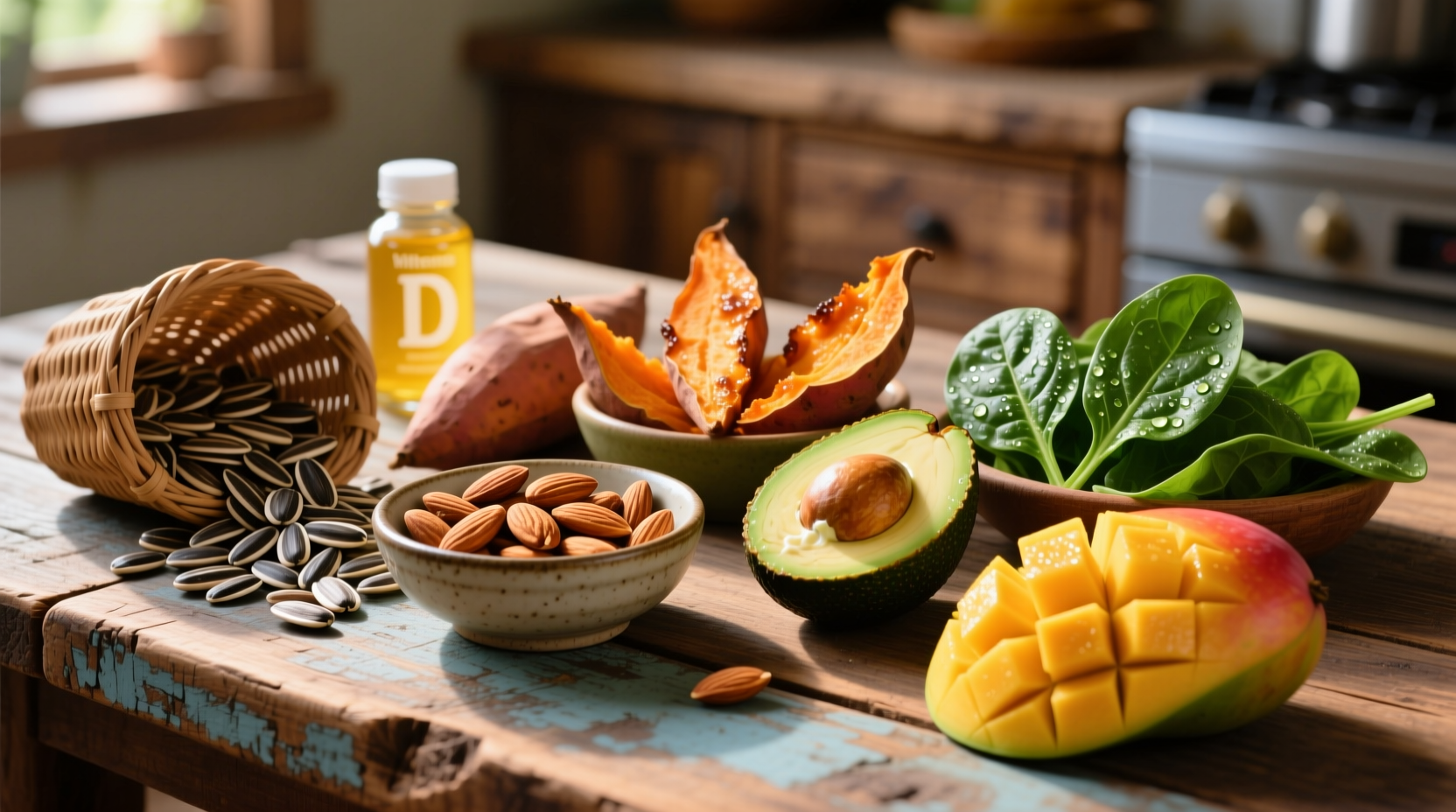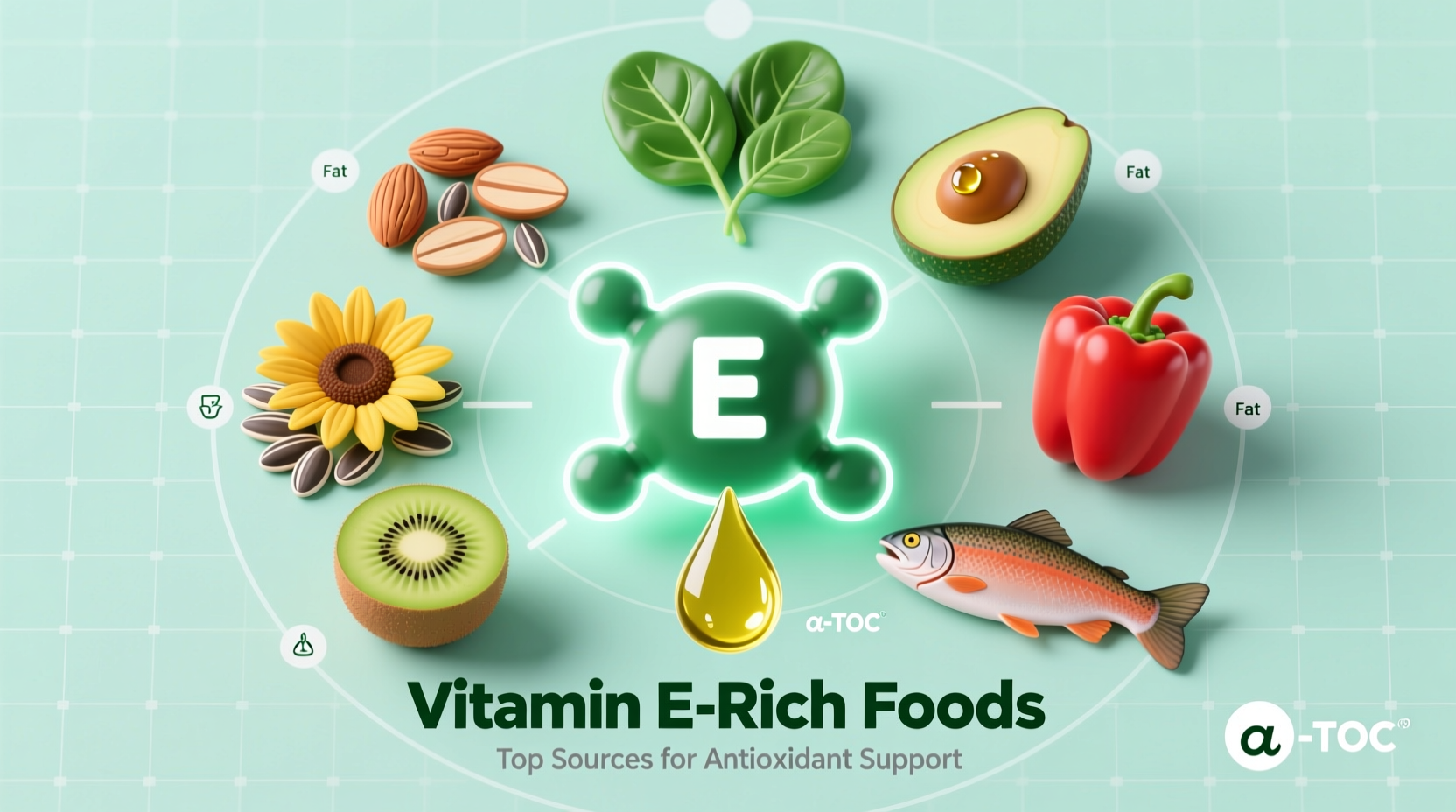Getting enough vitamin E through your diet is simpler than you might think. This essential fat-soluble antioxidant protects your cells from damage while supporting immune function and skin health. According to the National Institutes of Health, adults need 15 mg of vitamin E daily, and you can meet this requirement through common foods found in most grocery stores.
Top Vitamin E Food Sources by Category
Understanding which foods contain the highest concentrations of vitamin E helps you make strategic dietary choices. Vitamin E actually refers to eight different compounds, with alpha-tocopherol being the most biologically active form that your body uses. Let's explore the best natural sources organized by food category.
Nuts and Seeds: Powerhouse Vitamin E Sources
Nuts and seeds consistently rank among the richest sources of vitamin E. Their healthy fat content actually enhances vitamin E absorption since it's fat-soluble. Here's how popular options compare based on USDA FoodData Central measurements:
| Food (1 ounce serving) | Vitamin E (mg) | % Daily Value |
|---|---|---|
| Sunflower seeds (dry roasted) | 7.4 | 49% |
| Almonds (dry roasted) | 6.8 | 45% |
| Hazelnuts (raw) | 4.3 | 29% |
| Pine nuts (raw) | 2.6 | 17% |
| Peanuts (dry roasted) | 2.2 | 15% |
Just a small handful of almonds (about 23 nuts) provides nearly half your daily vitamin E requirement. Sunflower seeds offer similar benefits while adding a satisfying crunch to salads or yogurt.
Plant Oils: Concentrated Vitamin E Delivery
Certain plant-based oils contain exceptionally high concentrations of vitamin E. While you shouldn't consume these oils in large quantities due to their calorie density, using them in dressings or light cooking can significantly boost your intake:
- Wheat germ oil (1 tablespoon): 20.3 mg (135% DV) - the richest natural source
- Sunflower oil (1 tablespoon): 5.6 mg (37% DV)
- Safflower oil (1 tablespoon): 4.6 mg (31% DV)
- Canola oil (1 tablespoon): 2.4 mg (16% DV)
Wheat germ oil stands out as the most concentrated source, but its strong flavor means it's best used in small amounts in dressings rather than for high-heat cooking.

Vitamin E-Rich Vegetables and Fruits
While vegetables generally contain less vitamin E than nuts and oils, certain options still contribute meaningfully to your daily intake:
- Spinach (cooked): 1 cup provides 3.7 mg (25% DV)
- Broccoli (cooked): 1 cup provides 2.3 mg (15% DV)
- Kiwi: 1 medium fruit provides 1.1 mg (7% DV)
- Mango: 1 cup provides 0.9 mg (6% DV)
Remember that cooking vegetables with a small amount of healthy fat like olive oil significantly improves vitamin E absorption. The NIH notes that vitamin E absorption increases by 30-50% when consumed with dietary fats.
Practical Strategies for Maximizing Vitamin E Intake
Knowing which foods contain vitamin E is only half the equation. How you incorporate these foods matters just as much for optimal absorption and nutritional benefit.
Enhancing Vitamin E Absorption
Since vitamin E is fat-soluble, pairing it with healthy fats dramatically improves absorption. Try these simple techniques:
- Add a tablespoon of sunflower seeds to your spinach salad with olive oil dressing
- Blend almonds into smoothies with avocado for added healthy fats
- Use wheat germ oil in homemade vinaigrettes rather than heat-intensive cooking
- Serve roasted vegetables with a sprinkle of pine nuts or hazelnuts
A 2022 study published in the American Journal of Clinical Nutrition confirmed that vitamin E absorption increased by 43% when almonds were consumed with avocado compared to almonds alone. This demonstrates the importance of food combinations for nutrient optimization.
Daily Vitamin E Meal Plan Examples
Creating balanced meals that naturally incorporate vitamin E-rich foods ensures consistent daily intake. Here are two practical examples:
Breakfast: Greek yogurt with sliced almonds, sunflower seeds, and mango chunks (provides 7.2 mg vitamin E)
Lunch: Spinach salad with roasted chicken, sunflower seeds, and olive oil dressing (provides 6.8 mg vitamin E)
Dinner: Baked salmon with roasted broccoli and a sprinkle of pine nuts (provides 3.1 mg vitamin E)
This sample day totals approximately 17.1 mg of vitamin E, exceeding the recommended daily allowance while providing diverse nutrients from whole foods.
Important Considerations for Vitamin E Consumption
While getting vitamin E from food sources is generally safe and beneficial, certain considerations affect how much you need and how your body processes it.
Who Might Need More Vitamin E
Specific populations may require higher vitamin E intake due to increased needs or absorption challenges:
- Individuals with fat malabsorption disorders (cystic fibrosis, Crohn's disease)
- People with genetic variations affecting vitamin E metabolism
- Those following extremely low-fat diets (less than 10% of calories from fat)
- Older adults with reduced nutrient absorption efficiency
The National Academy of Medicine notes that vitamin E deficiency is rare in healthy individuals consuming balanced diets, but becomes more common in those with specific medical conditions affecting fat absorption.
When Supplements Might Be Necessary
While food sources should be your primary vitamin E source, supplements may be appropriate in specific situations under medical supervision:
- Diagnosed vitamin E deficiency confirmed by blood tests
- Certain genetic disorders affecting vitamin E metabolism
- Medical conditions causing severe fat malabsorption
The Mayo Clinic advises against high-dose vitamin E supplements (above 400 IU daily) due to potential increased risk of hemorrhagic stroke and other complications. Food sources provide vitamin E in safer, naturally balanced forms alongside other beneficial compounds.
Common Questions About Vitamin E Foods
What are the top 3 foods highest in vitamin E?
Wheat germ oil (20.3 mg per tablespoon), sunflower seeds (7.4 mg per ounce), and almonds (6.8 mg per ounce) are the three richest natural food sources of vitamin E. Just one tablespoon of wheat germ oil provides more than your entire daily requirement.
How much vitamin E do I need daily from food sources?
Adults need 15 mg (22.4 IU) of vitamin E daily according to the National Institutes of Health. You can meet this requirement through food combinations like one ounce of almonds (6.8 mg) plus one ounce of sunflower seeds (7.4 mg), which together provide nearly your entire daily need.
Does cooking destroy vitamin E in foods?
Vitamin E is relatively heat-stable compared to other vitamins. While some loss occurs during cooking, particularly in water-based methods, dry-heat cooking like roasting preserves most vitamin E content. Pairing vitamin E-rich foods with healthy fats during cooking actually enhances absorption.
Can I get enough vitamin E on a low-fat diet?
Getting adequate vitamin E on very low-fat diets (under 10% of calories) is challenging since vitamin E absorption depends on dietary fat. If following a low-fat diet, prioritize vitamin E-rich plant foods while including small amounts of healthy fats like avocado or olive oil to enhance absorption of this fat-soluble nutrient.











 浙公网安备
33010002000092号
浙公网安备
33010002000092号 浙B2-20120091-4
浙B2-20120091-4